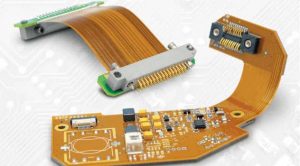The Role of Adhesives in the Construction of Rigid Flex Circuits
Construction of Rigid Flex Circuits
The unique construction of rigid flex circuits requires special consideration to ensure optimal reliability and performance. Rigid flex circuits combine the structural stability of rigid PCBs with flexible interconnects allowing for tighter traces and higher device populations. This allows for a smaller package size and lower overall weight versus multiple systems in separate rigid boards.
A common construction technique for rigid flex is to employ stiffeners, which are added to the upper layer of a flex circuit to offer support and help distribute weight evenly across both sides. These can be made from a variety of materials depending upon the application, but polyimide and FR-4 are common choices. Stiffeners can be incorporated into the design of a rigid flex PCB as part of the layout or they can be added during the lamination process.

Substrate Material Selection: The substrate material used to construct the rigid flex circuits must offer excellent electrical properties and be able to accommodate the bending and folding required for this type of hybrid technology. Careful consideration must also be given to the interface between rigid and flex sections, especially when the flex circuit will be subjected to repeated bending cycles.
The Role of Adhesives in the Construction of Rigid Flex Circuits
Copper Plating: The flex portion of a rigid flex circuit must be plated with high-quality copper to avoid corrosion and fatigue problems. RA copper is commonly used for flex PCBs, because it offers higher fatigue life than bare copper (relative to FR-4).
Pad Lands: Often, the pads on the flex section of the rigid flex circuit must be anchored with stubs and through-hole plating to allow for adequate mechanical integrity and solder wetting. Careful consideration must be given to the location and size of these stubs to prevent them from being damaged during bending or compression.
Adhesive Selection: When bonding the stubs and through-hole plating on a flex-rigid transition zone, careful attention must be paid to the choice of adhesives to be used. The selected adhesive must have good adhesion to both the copper and the flex-rigid substrate. Moreover, the adhesive must be capable of accommodating a reasonable amount of flex-rigid movement without delaminating or cracking.
Component Placement: Optimal placement of components on the flex portion of a rigid flex will minimize stress and damage to the circuit during assembly and operation. This involves determining appropriate bend radius limits for the flex section to prevent mechanical stresses from compromising electrical connections.
Rigid-flex PCBs streamline the manufacturing process by eliminating the need for extra connectors and cables to connect multiple rigid boards together. They also offer a more aesthetically pleasing product with the combination of the rigid and flexible areas in one integrated unit. This can lead to greater productivity and efficiency, reduced costs, shorter production times, and a safer and more durable product for consumers and users. The flexibility of the flex circuits also allows for high density device population and more compact conductors, freeing up space for other products features such as displays, batteries, power supplies and more.
